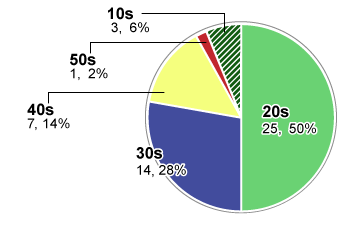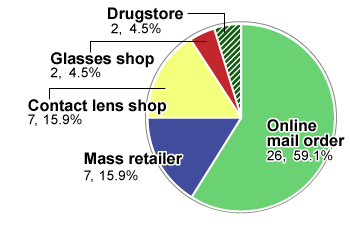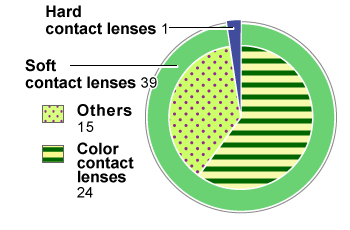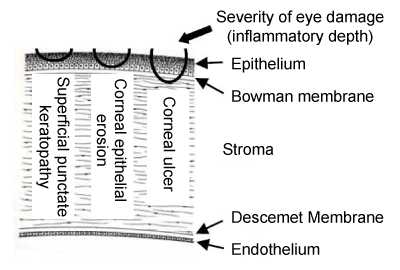Beware of eye damage from contact lenses (input through Doctor Mail Box)
NCAC has a data collecting section on its website titled "Accident information mail box to get input from doctors" (hereinafter called "Doctor Mail Box", which is a nickname) 1 set up in August 2014 in order to promptly get accident information and to prevent the occurrence and spread of similar incidents.
The Doctor Mail Box received 179 reports through July 20, 2017. Among them, 50 reports provided information on eye damage due to the use of contact lenses. 2
According to the survey in 2015 conducted by the Japan Ophthalmologists Association, 2,060 cases of eye damage from contact lenses were reported in one month. 3
In some cases, eye damage from contact lenses may become severe. NCAC conducted product tests and issued an alert several times in the past. 4
This time, NCAC decided to issue an alert to consumers again based on recent information on eye damage from contact lenses received by the Doctor Mail Box.
- 1 Accident information mail box to get input from doctors
- 2 The number of the cases was specially counted for this press release.
- 3 "Report on questionnaire survey results on eye damage from contact lenses in FY2015" issued in 2016 by the Japan Ophthalmologists Association
- 4 NCAC's press releases related to contact lenses (written in Japanese)
"Safety of color contact lenses - they might cause eye damage" on May 22, 2014
Summary
Reports on eye damage due to the use of contact lenses amounted to 50.
The breakdown of the cases showed that patients in their 20s and 30s accounted for 78.0% of all (See Diagram 1) and that female patients amounted to 41 (82.%) while male patients amounted to 9 (18.0%). In all the cases, users bought contact lenses without consulting any medical facility. The top three retail sources of contact lenses were: online mail order (26 cases, 59.1%), mass retailers (7 cases, 15.9%) and contact lens shops (7 cases, 15.9%) (See Diagram 2). Most cases were related to soft contact lenses (39 cases) including 24 cases related to color contact lenses (See Diagram 3).
Common types of eye damage were corneal epithelium disorder due to improper lens care (corneal infiltration, corneal ulcer, superficial keratitis, etc.), corneal endothelial trauma and corneal angiogenesis due to lack of oxygen after prolonged use of contact lenses.
The Ministry of Health, Labour and Welfare issued a notification on proper use of contact lenses in 2012 5 which stated "Sellers of contact lenses should ask consumers intending to buy contact lenses if they consulted a medical facility" and "If a consumer intending to buy contact lenses did not consult a medical facility, sellers of contact lenses should provide information on health damage from contact lenses and should recommend the consumer to consult a medical facility".
- 5 "How to keep informed about proper use of contact lenses" issued on July 18, 2012
Diagram 1: Generation of patients (n=50)
Patients in their 10s amounted to 3 (6.0%). Those in their 20s amounted to 25 (50.0%). Those in their 30s amounted to 14 (28.0%). Those in their 40s amounted to 7 (14.0%). Those in their 50s amounted to 1 (2.0%).
Diagram 2: Retail source (n=44)
Those who bought contact lenses through online mail order amounted to 26 (59.1%). Those who bought at a mass retailer amounted to 7 (15.9%). Those who bought at a contact lens shop amounted to 7 (15.9%). Those who bought at a glasses shop amounted to 2 (4.5%). Those who bought at a drugstore amounted to 2 (4.5%). Six unknown cases were not included in the graph.
Diagram 3: Types of lenses (n=40)
Cases related to soft contact lenses amounted to 39, while cases related to hard contact lenses amounted to 1. Among cases related to soft contact lenses, cases related to color contact lenses amounted to 24, while other cases amounted to 15. Ten unknown cases were not included in the graph.
Sampling of typical cases
- [Case 1] Corneal infiltration and superficial keratitis due to the use of color contact lenses which seemed to have been privately imported
- A patient said she suffered from blurred vision, bloodshot eyes, discharge, rheumy and gritty eyes. She was diagnosed as having corneal infiltration and superficial keratitis. She had been using unapproved color contact lenses which had been purchased through an online private import agency.
- (received in May 2017, woman in her 20s)
- [Case 2] Corneal erosion due to the use of poorly cared soft contact lenses which were purchased at a glasses shop
- A patient said she had suffered from blurred vision in the right eye since morning. She was diagnosed as having severe corneal erosion (treatment period: two weeks). The symptoms appeared to have been caused by improper use and care of contact lenses. She had continued to buy contact lenses at a glasses shop without an ophthalmologic examination for more than two years.
- (received in March 2017, woman in her 20s)
- [Case 3] Corneal infiltration and conjunctival erosion due to the use of poorly cared soft contact lenses which were purchased online
- A patient said her right eye had been bloodshot since the previous day. She was diagnosed as having corneal infiltration and conjunctive erosion in both eyes. The last time she underwent an ophthalmologic examination was two years before. Since then, she had continued to buy contact lenses online without an ophthalmologic examination. She seldom washed contact lenses by rubbing. Actually she had used two week contact lenses, but she had mistaken them for one month contact lenses.
- (received in March 2017, woman in her 20s)
- [Case 4] Giant papillary conjunctivitis and vascularization of cornea due to the use of contact lenses purchased at a mass retailer
- A patient said her eyes were itchy and bloodshot. After getting a prescription at an ophthalmic clinic two years before, she bought contact lenses five times at a mass retailer. She showed an empty package for contact lenses at the store and a store clerk easily sold the product to her, saying that the store had no contact lens advisor and could not be responsible for any eye damage. There were giant papillae on conjunctivas of her both eyes produced by eye irritation with contact lenses. Vascularization of cornea was also observed. It appeared that she had been using sluggish contact lenses.
- (received in January 2017, woman in her 20s)
- [Case 5] A patient was using soft contact lenses purchased online without properly cleaning them. About half of the cornea had erosion.
- A patient had continued to purchase two week soft contact lenses online for two years. She started to suffer from gritty sensation and brightness in her right eye two days before. Corneal erosion was observed in both eyes. Her right eye had more severe corneal erosion (about half of the cornea had erosion). Her corneal endothelium became thinner. Contact lenses were very dirty. She said she had sometimes slept with contact lenses on. She had never cleaned her contact lens case. It could cause blindness.
- (received in July 2015, woman in her 20s)
Reference Eye damage from contact lenses
Diagram 4: Structure of cornea and severity of eye damage
The most common eye damage from contact lenses is "superficial keratitis", an inflammatory condition of the cornea. As the inflammation becomes wider and deeper, it develops into "corneal epithelial erosion" and "corneal ulcer".
"Vascularization of cornea" is a severe eye impairment by which a blood vessel from the conjunctiva, etc. extends into the cornea toward the corneal center (normally there is no blood vessel in the cornea).
"Giant papillary conjunctivitis" is an eye impairment by which papillae are generated on the rear side of the upper eyelid (conjunctiva).
- Corneal epithelial erosion: The corneal epithelial layer on the surface of black eye partly falls off, which causes pain. It is curable with medical treatment in about one week.
- Corneal filtration: Inflammatory conditions of corneal epithelial layer or corneal stromal layer. If any infection is present, it tends to become severe.
- Corneal ulcer: Damaged conditions of the corneal stroma due to infection, etc., which is a severe eye impairment. In the worst case, there may be a hole in the cornea or vision loss due to bacterial eyeball infection.
Advice for consumers
(1) When buying contact lenses, be sure to consult an eye doctor and choose contact lenses in accordance with the ophthalmologist's prescription.
Contact lenses are specially controlled medical devices. It is essential to have an ophthalmologist's prescription to choose suitable contact lenses and to use them safely and comfortably. Be sure to consult an eye doctor to get an ophthalmologist's prescription before using contact lenses.
Reports included cases of eye damage which appear to have been caused by the use of unapproved color contact lenses. Safety and quality of unofficially imported contact lenses are not confirmed by the Japanese government. Do not easily buy such products.
(2) Follow the expiration date. Properly care for reusable contact lenses after each use.
The Doctor Mail Box received cases of eye damage caused by the use of contact lenses longer than the expiration period or by the use of poorly cared contact lenses.
Even if using contact lenses in accordance with ophthalmologist's prescription, poorly cared or dirty contact lenses may cause severe eye damage in addition to discomfort sensation. Follow the expiration date. In case of reusable contact lenses, properly care for them after each use.
(3) If you feel abnormality in your eyes when using contact lenses, stop using them immediately and consult an eye doctor. Even if you don't feel abnormality, be sure to have regular checkups.
If you feel abnormality in your eyes when using contact lenses, you may suffer from severe eye damage. In that case, stop using contact lenses right away and consult an eye doctor. Even if you don't notice any symptoms, you might suffer from eye damage. Get a regular checkup once in three months even if you don't feel abnormality in your eyes.
